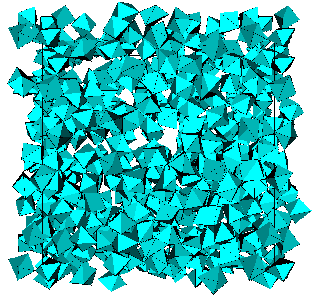Modelling the NaPbM2F9
(M = Fe, V) Fluoride Glass Structures
Armel
Le Bail
Laboratoire des Fluorures, Université du Maine, Avenue
Olivier Messiaen, 72085 Le Mans cedex 9, France.
Abstract
 Fluoride
glasses with nominal composition NaPbM2F9
(M = Fe, V, assuming isomorphous replacement) have been structurally modelled
through the simultaneous simulation of their neutron and X-ray diffraction
patterns by Reverse Monte Carlo (RMC) and by a Rietveld for disordered
materials (RDM) method. Models and methods are discussed and compared.
Originality lies in the glass network expected to be based on interconnected
[MF6] octahedra.
Fluoride
glasses with nominal composition NaPbM2F9
(M = Fe, V, assuming isomorphous replacement) have been structurally modelled
through the simultaneous simulation of their neutron and X-ray diffraction
patterns by Reverse Monte Carlo (RMC) and by a Rietveld for disordered
materials (RDM) method. Models and methods are discussed and compared.
Originality lies in the glass network expected to be based on interconnected
[MF6] octahedra.
Introduction
Motivations and experimental
RMC modelling
RDM modelling
Solid state chemistry considerations
Comparing RMC and RDM methods
Conclusion
References
Supplementary material (data, VRML
3D views and PC softwares)
RMC
Modelling Internet Conference 1997
 Fluoride
glasses with nominal composition NaPbM2F9
(M = Fe, V, assuming isomorphous replacement) have been structurally modelled
through the simultaneous simulation of their neutron and X-ray diffraction
patterns by Reverse Monte Carlo (RMC) and by a Rietveld for disordered
materials (RDM) method. Models and methods are discussed and compared.
Originality lies in the glass network expected to be based on interconnected
[MF6] octahedra.
Fluoride
glasses with nominal composition NaPbM2F9
(M = Fe, V, assuming isomorphous replacement) have been structurally modelled
through the simultaneous simulation of their neutron and X-ray diffraction
patterns by Reverse Monte Carlo (RMC) and by a Rietveld for disordered
materials (RDM) method. Models and methods are discussed and compared.
Originality lies in the glass network expected to be based on interconnected
[MF6] octahedra.